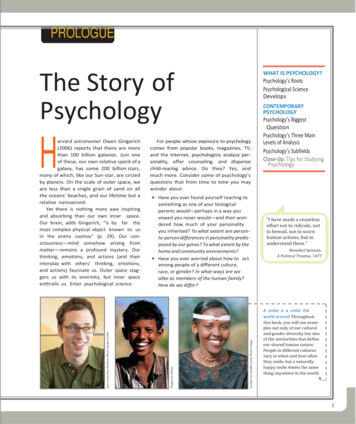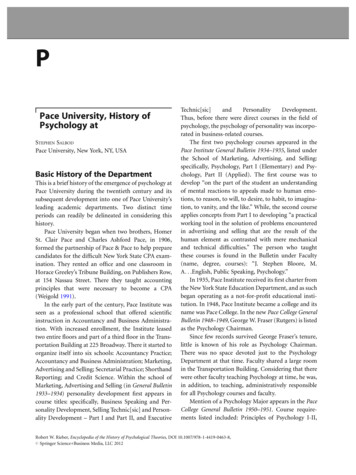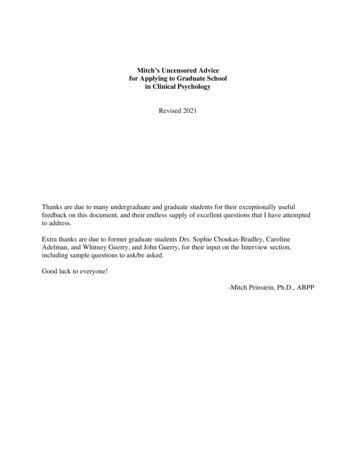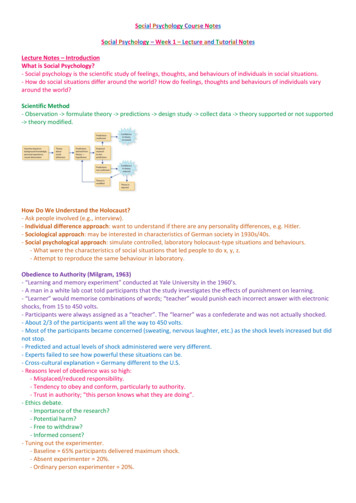
Transcription
HANDBOOKofPSYCHOLOGY
HANDBOOKofPSYCHOLOGYVOLUME 12INDUSTRIAL AND ORGANIZATIONAL PSYCHOLOGYWalter C. BormanDaniel R. IlgenRichard J. KlimoskiVolume EditorsIrving B. WeinerEditor-in-ChiefJohn Wiley & Sons, Inc.
➇This book is printed on acid-free paper.Copyright 2003 by John Wiley & Sons, Inc., Hoboken, New Jersey. All rights reserved.Published simultaneously in Canada.No part of this publication may be reproduced, stored in a retrieval system, or transmitted in any form or by any means, electronic,mechanical, photocopying, recording, scanning, or otherwise, except as permitted under Section 107 or 108 of the 1976 UnitedStates Copyright Act, without either the prior written permission of the Publisher, or authorization through payment of theappropriate per-copy fee to the Copyright Clearance Center, Inc., 222 Rosewood Drive, Danvers, MA 01923, (978) 750-8400,fax (978) 750-4470, or on the web at www.copyright.com. Requests to the Publisher for permission should be addressed to thePermissions Department, John Wiley & Sons, Inc., 111 River Street, Hoboken, NJ 07030, (201) 748-6011, fax (201) 748-6008,e-mail: permcoordinator@wiley.com.Limit of Liability/Disclaimer of Warranty: While the publisher and author have used their best efforts in preparing this book, theymake no representations or warranties with respect to the accuracy or completeness of the contents of this book and specificallydisclaim any implied warranties of merchantability or fitness for a particular purpose. No warranty may be created or extended bysales representatives or written sales materials. The advice and strategies contained herein may not be suitable for your situation.You should consult with a professional where appropriate. Neither the publisher nor author shall be liable for any loss of profit orany other commercial damages, including but not limited to special, incidental, consequential, or other damages.This publication is designed to provide accurate and authoritative information in regard to the subject matter covered. It is soldwith the understanding that the publisher is not engaged in rendering professional services. If legal, accounting, medical,psychological or any other expert assistance is required, the services of a competent professional person should be sought.Designations used by companies to distinguish their products are often claimed as trademarks. In all instances where John Wiley &Sons, Inc. is aware of a claim, the product names appear in initial capital or all capital letters. Readers, however, should contact theappropriate companies for more complete information regarding trademarks and registration.For general information on our other products and services please contact our Customer Care Department within the U.S. at(800) 762-2974, outside the United States at (317) 572-3993 or fax (317) 572-4002.Wiley also publishes its books in a variety of electronic formats. Some content that appears in print may not be available inelectronic books.Library of Congress Cataloging-in-Publication Data:Handbook of psychology / Irving B. Weiner, editor-in-chief.p. cm.Includes bibliographical references and indexes.Contents: v. 1. History of psychology / edited by Donald K. Freedheim — v. 2. Researchmethods in psychology / edited by John A. Schinka, Wayne F. Velicer — v. 3. Biologicalpsychology / edited by Michela Gallagher, Randy J. Nelson — v. 4. Experimentalpsychology / edited by Alice F. Healy, Robert W. Proctor — v. 5. Personality and socialpsychology / edited by Theodore Millon, Melvin J. Lerner — v. 6. Developmentalpsychology / edited by Richard M. Lerner, M. Ann Easterbrooks, Jayanthi Mistry — v. 7.Educational psychology / edited by William M. Reynolds, Gloria E. Miller — v. 8.Clinical psychology / edited by George Stricker, Thomas A. Widiger — v. 9. Health psychology /edited by Arthur M. Nezu, Christine Maguth Nezu, Pamela A. Geller — v. 10. Assessmentpsychology / edited by John R. Graham, Jack A. Naglieri — v. 11. Forensic psychology /edited by Alan M. Goldstein — v. 12. Industrial and organizational psychology / editedby Walter C. Borman, Daniel R. Ilgen, Richard J. Klimoski.ISBN 0-471-17669-9 (set) — ISBN 0-471-38320-1 (cloth : alk. paper : v. 1)— ISBN 0-471-38513-1 (cloth : alk. paper : v. 2) — ISBN 0-471-38403-8 (cloth : alk. paper : v. 3)— ISBN 0-471-39262-6 (cloth : alk. paper : v. 4) — ISBN 0-471-38404-6 (cloth : alk. paper : v. 5)— ISBN 0-471-38405-4 (cloth : alk. paper : v. 6) — ISBN 0-471-38406-2 (cloth : alk. paper : v. 7)— ISBN 0-471-39263-4 (cloth : alk. paper : v. 8) — ISBN 0-471-38514-X (cloth : alk. paper : v. 9)— ISBN 0-471-38407-0 (cloth : alk. paper : v. 10) — ISBN 0-471-38321-X (cloth : alk. paper : v. 11)— ISBN 0-471-38408-9 (cloth : alk. paper : v. 12)1. Psychology. I. Weiner, Irving B.BF121.H1955 2003150—dc212002066380Printed in the United States of America.10987654321
Editorial BoardVolume 1History of PsychologyVolume 5Personality and Social PsychologyVolume 9Health PsychologyDonald K. Freedheim, PhDCase Western Reserve UniversityCleveland, OhioTheodore Millon, PhDInstitute for Advanced Studies inPersonology and PsychopathologyCoral Gables, FloridaArthur M. Nezu, PhDChristine Maguth Nezu, PhDPamela A. Geller, PhDVolume 2Research Methods in PsychologyMelvin J. Lerner, PhDFlorida Atlantic UniversityBoca Raton, FloridaJohn A. Schinka, PhDUniversity of South FloridaTampa, FloridaVolume 6Developmental PsychologyWayne F. Velicer, PhDUniversity of Rhode IslandKingston, Rhode IslandRichard M. Lerner, PhDM. Ann Easterbrooks, PhDJayanthi Mistry, PhDTufts UniversityMedford, MassachusettsVolume 3Biological PsychologyMichela Gallagher, PhDJohns Hopkins UniversityBaltimore, MarylandRandy J. Nelson, PhDOhio State UniversityColumbus, OhioVolume 7Educational PsychologyWilliam M. Reynolds, PhDHumboldt State UniversityArcata, CaliforniaDrexel UniversityPhiladelphia, PennsylvaniaVolume 10Assessment PsychologyJohn R. Graham, PhDKent State UniversityKent, OhioJack A. Naglieri, PhDGeorge Mason UniversityFairfax, VirginiaVolume 11Forensic PsychologyAlan M. Goldstein, PhDJohn Jay College of CriminalJustice–CUNYNew York, New YorkGloria E. Miller, PhDUniversity of DenverDenver, ColoradoVolume 12Industrial and OrganizationalPsychologyVolume 4Experimental PsychologyVolume 8Clinical PsychologyWalter C. Borman, PhDUniversity of South FloridaTampa, FloridaAlice F. Healy, PhDUniversity of ColoradoBoulder, ColoradoGeorge Stricker, PhDAdelphi UniversityGarden City, New YorkDaniel R. Ilgen, PhDMichigan State UniversityEast Lansing, MichiganRobert W. Proctor, PhDPurdue UniversityWest Lafayette, IndianaThomas A. Widiger, PhDUniversity of KentuckyLexington, KentuckyRichard J. Klimoski, PhDGeorge Mason UniversityFairfax, Virginiav
To the Society for Industrial and Organizational Psychology
Handbook of Psychology PrefacePsychology at the beginning of the twenty-first century hasbecome a highly diverse field of scientific study and appliedtechnology. Psychologists commonly regard their disciplineas the science of behavior, and the American PsychologicalAssociation has formally designated 2000 to 2010 as the“Decade of Behavior.” The pursuits of behavioral scientistsrange from the natural sciences to the social sciences and embrace a wide variety of objects of investigation. Some psychologists have more in common with biologists than withmost other psychologists, and some have more in commonwith sociologists than with most of their psychological colleagues. Some psychologists are interested primarily in the behavior of animals, some in the behavior of people, and othersin the behavior of organizations. These and other dimensionsof difference among psychological scientists are matched byequal if not greater heterogeneity among psychological practitioners, who currently apply a vast array of methods in manydifferent settings to achieve highly varied purposes.Psychology has been rich in comprehensive encyclopedias and in handbooks devoted to specific topics in the field.However, there has not previously been any single handbookdesigned to cover the broad scope of psychological scienceand practice. The present 12-volume Handbook of Psychology was conceived to occupy this place in the literature.Leading national and international scholars and practitionershave collaborated to produce 297 authoritative and detailedchapters covering all fundamental facets of the discipline,and the Handbook has been organized to capture the breadthand diversity of psychology and to encompass interests andconcerns shared by psychologists in all branches of the field.Two unifying threads run through the science of behavior.The first is a common history rooted in conceptual and empirical approaches to understanding the nature of behavior.The specific histories of all specialty areas in psychologytrace their origins to the formulations of the classical philosophers and the methodology of the early experimentalists, andappreciation for the historical evolution of psychology in allof its variations transcends individual identities as being onekind of psychologist or another. Accordingly, Volume 1 inthe Handbook is devoted to the history of psychology asit emerged in many areas of scientific study and appliedtechnology.A second unifying thread in psychology is a commitmentto the development and utilization of research methodssuitable for collecting and analyzing behavioral data. Withattention both to specific procedures and their applicationin particular settings, Volume 2 addresses research methodsin psychology.Volumes 3 through 7 of the Handbook present the substantive content of psychological knowledge in five broadareas of study: biological psychology (Volume 3), experimental psychology (Volume 4), personality and social psychology (Volume 5), developmental psychology (Volume 6),and educational psychology (Volume 7). Volumes 8 through12 address the application of psychological knowledge infive broad areas of professional practice: clinical psychology(Volume 8), health psychology (Volume 9), assessment psychology (Volume 10), forensic psychology (Volume 11), andindustrial and organizational psychology (Volume 12). Eachof these volumes reviews what is currently known in theseareas of study and application and identifies pertinent sourcesof information in the literature. Each discusses unresolved issues and unanswered questions and proposes future directions in conceptualization, research, and practice. Each of thevolumes also reflects the investment of scientific psychologists in practical applications of their findings and the attention of applied psychologists to the scientific basis of theirmethods.The Handbook of Psychology was prepared for the purpose of educating and informing readers about the presentstate of psychological knowledge and about anticipated advances in behavioral science research and practice. With thispurpose in mind, the individual Handbook volumes addressthe needs and interests of three groups. First, for graduate students in behavioral science, the volumes provide advancedinstruction in the basic concepts and methods that define thefields they cover, together with a review of current knowledge, core literature, and likely future developments. Second,in addition to serving as graduate textbooks, the volumesoffer professional psychologists an opportunity to read andcontemplate the views of distinguished colleagues concerning the central thrusts of research and leading edges of practice in their respective fields. Third, for psychologists seekingto become conversant with fields outside their own specialtyix
xHandbook of Psychology Prefaceand for persons outside of psychology seeking information about psychological matters, the Handbook volumesserve as a reference source for expanding their knowledgeand directing them to additional sources in the literature.The preparation of this Handbook was made possible bythe diligence and scholarly sophistication of the 25 volumeeditors and co-editors who constituted the Editorial Board.As Editor-in-Chief, I want to thank each of them for the pleasure of their collaboration in this project. I compliment themfor having recruited an outstanding cast of contributors totheir volumes and then working closely with these authors toachieve chapters that will stand each in their own right asvaluable contributions to the literature. I would like finally toexpress my appreciation to the editorial staff of John Wileyand Sons for the opportunity to share in the development ofthis project and its pursuit to fruition, most particularly toJennifer Simon, Senior Editor, and her two assistants, MaryPorterfield and Isabel Pratt. Without Jennifer’s vision of theHandbook and her keen judgment and unflagging support inproducing it, the occasion to write this preface would nothave arrived.IRVING B. WEINERTampa, Florida
ContentsHandbook of Psychology Preface ixIrving B. WeinerContributors xiii1STABILITY AND CHANGE IN INDUSTRIAL AND ORGANIZATIONAL PSYCHOLOGY 1Walter C. Borman, Daniel R. Ilgen, and Richard J. KlimoskiPA RT O N EPERSONNEL PSYCHOLOGY2JOB AND WORK ANALYSIS 21Paul R. Sackett and Roxanne M. Laczo3JOB PERFORMANCE 39Stephan J. Motowidlo4RECRUITMENT RESEARCH IN THE TWENTY-FIRST CENTURY 55Sara L. Rynes and Daniel M. Cable5PERSONNEL SELECTION AND EMPLOYEE PERFORMANCE 77Neal Schmitt, Jose M. Cortina, Michael J. Ingerick, and Darin Wiechmann6INTELLIGENCE AND THE WORKPLACE 107Fritz Drasgow7USE OF PERSONALITY VARIABLES IN WORK SETTINGS 131Leaetta M. Hough and Adrian Furnham8PERSPECTIVES ON TRAINING AND DEVELOPMENT 171Kurt Kraiger9STRATEGIC INDUSTRIAL AND ORGANIZATIONAL PSYCHOLOGY AND THE ROLE OF UTILITYANALYSIS MODELS 193John W. Boudreau and Peter M. RamstadPA RT T W OORGANIZATIONAL PSYCHOLOGY10MOTIVATION 225Terence R. Mitchell and Denise Danielsxi
xiiContents11JOB ATTITUDES 255Charles L. Hulin and Timothy A. Judge12LEADERSHIP MODELS, METHODS, AND APPLICATIONS 277Bruce J. Avolio, John J. Sosik, Dong I. Jung, and Yair Berson13THEORIES AND PRACTICES OF ORGANIZATIONAL DEVELOPMENT 309John R. Austin and Jean M. Bartunek14WORK GROUPS AND TEAMS IN ORGANIZATIONS 333Steve W. J. Kozlowski and Bradford S. Bell15CUSTOMER SERVICE BEHAVIOR 377Ann Marie Ryan and Robert E. PloyhartPA RT T H R E ETHE WORK ENVIRONMENT16CHANGES IN WORKERS, WORK, AND ORGANIZATIONS 401Wayne F. Cascio17WORK DESIGN 423Frederick P. Morgeson and Michael A. Campion18STRESS IN ORGANIZATIONS 453Sabine Sonnentag and Michael Frese19JUDGMENT AND DECISION MAKING 493Terry Connolly and Lisa Ordóñez20CAREER DYNAMICS 519Jeffrey H. Greenhaus21HUMAN FACTORS AND ERGONOMICS 541William C. Howell22ORGANIZATIONAL CULTURE AND CLIMATE 565Cheri Ostroff, Angelo J. Kinicki, and Melinda M. Tamkins23DIVERSITY IN ORGANIZATIONS 595Clayton P. Alderfer and Adrienne D. SimsAuthor Index 615Subject Index 639
ContributorsClayton P. Alderfer, PhDGraduate School of Professional PsychologyRutgers UniversityPiscataway, New JerseyWayne F. Cascio, PhDDepartment of ManagementUniversity of ColoradoDenver, ColoradoJohn R. Austin, PhDPennsylvania State UniversityPittsburgh, PennsylvaniaTerry Connolly, PhDDepartment of Management and PolicyUniversity of ArizonaTucson, ArizonaBruce J. Avolio, PhDSchool of ManagementCenter for Leadership StudiesBinghamton UniversityBinghamton, New YorkJose M. Cortina, PhDDepartment of PsychologyGeorge Mason UniversityFairfax, VirginiaJean M. Bartunek, PhDDepartment of Organization StudiesBoston CollegeChestnut Hill, MassachusettsDenise Daniels, PhDBusiness and Economics DepartmentSeattle Pacific UniversitySeattle, WashingtonBradford S. BellSchool of Industrial and Labor RelationsCornell UniversityFritz Drasgow, PhDDepartment of PsychologyUniversity of Illinois atUrbana-ChampaignChampaign, IllinoisYair Berson, PhDPolytechnic UniversityNew York, New YorkMichael Frese, PhDDepartment of PsychologyUniversity of GiessenGiessen, GermanyWalter C. BormanUniversity of South FloridaTampa, FloridaJohn W. Boudreau, PhDILR Human Resource StudiesCornell UniversityIthaca, New YorkAdrian Furnham, PhDDepartment of PsychologyUniversity College LondonLondon, EnglandDaniel M. Cable, PhDKenan-Flagler Business SchoolUniversity of North Carolina at Chapel HillChapel Hill, North CarolinaJeffrey H. Greenhaus, PhDDepartment of ManagementDrexel UniversityPhiladelphia, PennsylvaniaMichael A. Campion, PhDKrannert Graduate School of ManagementPurdue UniversityWest Lafayette, IndianaLeaetta M. Hough, PhDThe Dunnette Group, Ltd.St. Paul, Minnesotaxiii
xivContributorsWilliam C. Howell, PhDDepartment of PsychologyArizona State and Rice UniversitiesGold Canyon, ArizonaTerence R. Mitchell, PhDSchool of BusinessUniversity of WashingtonSeattle, WashingtonCharles L. Hulin, PhDDepartment of PsychologyUniversity of Illinois at Urbana-ChampaignChampaign, IllinoisFrederick P. Morgeson, PhDDepartment of ManagementTexas A&M UniversityCollege Station, TexasDaniel R. IlgenMichigan State UniversityEast Lansing, MichiganStephan J. Motowidlo, PhDDepartment of PsychologyUniversity of MinnesotaMinneapolis, MinnesotaMichael J. IngerickDepartment of PsychologyGeorge Mason UniversityFairfax, VirginiaTimothy A. Judge, PhDDepartment of BusinessUniversity of IowaIowa City, IowaDong I. Jung, PhDDepartment of ManagementSan Diego State UniversitySan Diego, CaliforniaAngelo J. Kinicki, PhDArizona State UniversityPhoenix, ArizonaRichard J. KlimoskiGeorge Mason UniversityFairfax, VirginiaSteve W. J. Kozlowski, PhDDepartment of PsychologyMichigan State UniversityEast Lansing, MichiganLisa Ordóñez, PhDDepartment of Management and PolicyUniversity of ArizonaTucson, ArizonaCheri Ostroff, PhDTeachers CollegeColumbia UniversityNew York, New YorkRobert E. Ployhart, PhDDepartment of PsychologyGeorge Mason UniversityFairfax, VirginiaPeter M. RamstadPersonnel Decisions InternationalMinneapolis, MinnesotaAnn Marie Ryan, PhDDepartment of PsychologyMichigan State UniversityEast Lansing, MichiganKurt Kraiger, PhDDepartment of PsychologyUniversity of ColoradoDenver, ColoradoSara L. Rynes, PhDDepartment of Managementand OrganizationsTippie College of BusinessUniversity of IowaIowa City, IowaRoxanne M. LaczoDepartment of PsychologyUniversity of MinnesotaMinneapolis, MinnesotaPaul R. Sackett, PhDDepartment of PsychologyUniversity of MinnesotaMinneapolis, Minnesota
ContributorsNeal Schmitt, PhDDepartment of PsychologyMichigan State UniversityEast Lansing, MichiganAdrienne D. SimsGraduate School of Professional PsychologyRutgers UniversityPiscataway, New JerseySabine Sonnentag, PhDDepartment of PsychologyUniversity of KonstanzKonstanz, GermanyJohn J. Sosik, PhDDepartment of ManagementPenn State Great ValleyMalvern, PennsylvaniaMelinda M. TamkinsTeachers CollegeColumbia UniversityNew York, New YorkDarin WiechmannDepartment of PsychologyMichigan State UniversityEast Lansing, Michiganxv
CHAPTER 1Stability and Change in Industrialand Organizational PsychologyWALTER C. BORMAN, RICHARD J. KLIMOSKI, AND DANIEL R. ILGENHandbooks Past and Present 1Industrial-Organizational Psychology:Overarching Models 1INDUSTRIAL AND ORGANIZATIONAL PSYCHOLOGY INTHE 1990S 3Advances by Elaboration 3Advances Through Extension 6Chapters Comprising This HandbookREFERENCES 14Handbooks Past and Presentbelieve they did this very well—and did it in such a way thatthis volume can serve as a sequel to the handbook of the 1990s,informing and guiding industrial and organizational psychology in the early part of the twenty-first century.What follows begins by addressing the field of industrialand organizational psychology as a whole and describingsome of the major accomplishments and new directions thathave occurred since the publishing of the Dunnette andHough handbook. After some discussion of our disciplineand advancements in this field, we turn to a preview of individual chapters.In the mid-1970s Marvin D. Dunnette edited the first handbook of industrial and organizational psychology (Dunnette,1976). This prodigious work brought together the writings ofthe leading scholars in the field under one cover and acted as afoundation and guide for the field for the next 15 years. In theearly 1990s Dunnette did it again. The second edition, editedby Dunnette and Leaetta M. Hough, maintained the same highquality of the first but expanded significantly from one to fourvolumes, each approximately 800 pages (Dunnette & Hough,1990, 1991, 1992, 1994, vols. 1–4, respectively). The definitive reviews and even visionary statements targeted virtuallyall areas of industrial and organizational psychology andagain set the standards for the field.Knowing the standard to which we would be inevitablycompared, we undertook the task of editing the present volumewith great trepidation. Ours was a more modest and somewhatdifferent objective. As a single volume nested within a handbook for all of psychology, our purpose was to provide thedepth and breadth that would capture the domain of industrialand organizational psychology in a way valuable for scholarsand students in that field domain; however, we also strove tocreate a volume to which those outside the field could turn inorder to gain an appreciation of the latest thinking in this areaof interest. To accomplish these purposes, we have again assembled a collection of leading scholars in the field. We askedthem to describe the work in their area, but to do so in a waythat would speak to both those inside and outside the field; we10Industrial and Organizational Psychology:Overarching ModelsIndustrial and organizational psychology is the study ofhuman behavior in organizations; the behaviors of interestcontribute to either the effectiveness of organizational functioning, the satisfaction and well-being of those who populatethe organizations, or both. These behaviors and the peoplewho exhibit them exist in a dynamic open system (Katz &Kahn, 1978). Behaviors observed in the present are influenced by past behaviors and conditions, as well as by the anticipation of future ones. Individuals are systems nestedwithin other systems—such as teams and work groups—thatare nested under larger organizational systems. All of thesesystems are open to the outside through connections to family members, customers, and multiple other potential sourcesof influence on organizational members’ behavior.1
2Stability and Change in Industrial and Organizational PsychologyOpen SystemsAlthough open systems models capture the complexities of apsychology bound by the context in which the behaviorsoccur, the field of industrial and organizational psychologyhas—for the most part—constrained its domain to that of theinterface between individuals and their environments, wherethat environment is physical (tasks, jobs, working conditions,organizational structures) or social (superiors, subordinates,peers). Furthermore, the beliefs, feelings, and behaviors ofinterest within that domain are limited to those for whichthere is some reason to believe that understanding them willenhance our ability to influence organizational effectivenessor individual well-being.FitUnderlying the psychological focus on individuals in organizational settings is the implicit assumption that both the organization and the individual are best served when there is agood fit between the goals, expectations, and conditions of organizations (e.g., jobs) with the characteristics of the peoplein them. From a prescriptive viewpoint, there are many waysto obtain a good fit. One is to consider organizations and people as relatively fixed entities. From this position, characteristics of each entity are assessed and the match is accomplishedthrough selection—selection of people by organizations ororganizations by people. The second option to obtain fit isto modify either or both of the two domains. In the caseof changing people, training and development are primarymechanisms. Job design, organizational development, organizational design, or policies and practices related to goals,work rules, and other factors are relevant for changing organizations. For any particular case, multiple factors influence thefit, and the fit is a dynamic interaction between people and theorganization, with each influencing the other over time. In addition, of course, while efforts at producing good fit are underway, both the individual and the organization are subject toevolutionary forces outside of the control of either the leadersof an organization or those whom they trust as advisors.For much of industrial and organizational psychologicalresearch, the person-organization (P-O) fit has been implicit.In the last decade, considerably more effort has been devotedto developing it explicitly. The P-O model posits that a fit between applicants’ personal characteristics and attributes of theorganization contributes in important ways to individual performance and retention, as well as to organizational effectiveness. One way to demonstrate support for the P-O model is tofind interactions between applicants’ personal characteristicsand organizational attributes. For example, Cable and Judge(1994) showed that a fit between applicants’ personality andpay system characteristics enhanced the prediction of paypreferences and job attractiveness over and above the main effects of pay system characteristics themselves. Gustafson andMumford (1995) found that individuals’ personality predictedjob satisfaction and performance better when the type ofjob situation was taken into account, supporting a P-O fitinterpretation.An important issue with P-O fit is how to conceptualize andmeasure it. Kristof (1996) pointed out that there has been considerable confusion on this issue. For example, P-O fit may beconceived of as person-environment congruence that confounds P-O fit with person-vocation and person-job fit. Also,fit has been measured directly by obtaining a single judgmentof congruence between applicant and organizational characteristics and indirectly by getting independent judgments ofperson and organization characteristics and then assessing thesimilarities and differences. Finally, for the indirect approach,various indexes of fit are of course possible. Edwards (1994)provided a useful discussion of fit indexes and recommendeda polynomial regression approach to overcome certain measurement problems. However, subsequent analysis (Kristof,1996; Schneider, Goldstein, & Smith, 1995) has shown thatthis method poses some limitations as well.The most compelling theoretical approach to modelingP-O fit is the attraction-selection-attrition (ASA) model(Schneider, 1987). Those who advocate this approach arguethat individuals are attracted to organizations whose membersare similar to them in relation to personality, values, and otherattributes. Organizations in turn find attractive and are morelikely to select those who possess knowledge, skills, and abilities similar to the ones that their organizational memberspossess. After they have been offered a job, those more similar are more likely to accept the job and are also more likely tobe successfully socialized into the organization. Over time,those who do not fit well are more likely to leave—either ontheir own accord or because of problems on the job. Thus, thecontinuous process of attraction, assimilation, and attritionover time creates a force toward a fit between the peopleemployed in the organization at any one time and the needsand expectations of that organization. The process is a lessthan-perfect one in the sense that it does not create a perfect fitbetween all employees, their work, and those with whom theywork, but it does create a force toward fit.An important component of ASA theory is the gravitational hypothesis; this hypothesis posits that over time, people will gravitate to organizations that have values, attitudes,and so on that are similar to theirs. Empirical tests of thishypothesis have shown some support. For example, Wilk,Desmarais, and Sackett (1995) found that general cognitive
Industrial and Organizational Psychology in the 1990sability is a good predictor of movement to jobs of higher orlower complexity 5 years later.Schneider et al. (1995) provided an update on ASA research and thinking. Regarding personnel selection in theASA context, these authors point out that if P-O fit is to beconsidered important, organizational diagnosis should be included in the job analysis strategy and that personality islikely to be a useful predictor of turnover and job performance because of the positive individual and organizationaloutcomes associated with homogeneity. Schneider et al.(1995) also argued that organizational homogeneity in personality, attitudes, and values is usually good early in the lifeof an organization because of its positive effect on cooperation and communication; however, such homogeneity overtime may lead to an inability for the organization to adapt tochanging external environments.On balance, as organizational flexibility in effectivelyusing employees is increasingly required (e.g., more movement of organization members from job to job or task force totask force), the P-O fit model may be more relevant comparedto the person-job match strategy (e.g., Kristof, 1996) of thepast. We think that both models will continue to have merit.Aptitude-Treatment InteractionUsing Gough’s (1957) terminology, in which aptitude represents individual difference characteristics of people andtreatment is broadly defined as situations encountered bypeople (job characteristics, working conditions, supervisors,performance goals, etc.), John Campbell (1999) cogently argued that all industrial and organizational psychology is captured by aptitudes, treatment, and their interaction. In almostall cases, the dependent variables important to the field can becaptured by individual, work group, or team performance;withdrawal behaviors such as absenteeism, turnover, or lackof attention to work; self-evaluation of the job or facets of thework setting (e.g., job satisfaction); or self-evaluation of fairtreatment at work. Constructs that fall into eithe
industrial and organizational psychology (Volume 12). Each of these volumes reviews what is currently known in these areas of study and application and identifies pertinent sources of information in the literature. Each discusses unresolved is










